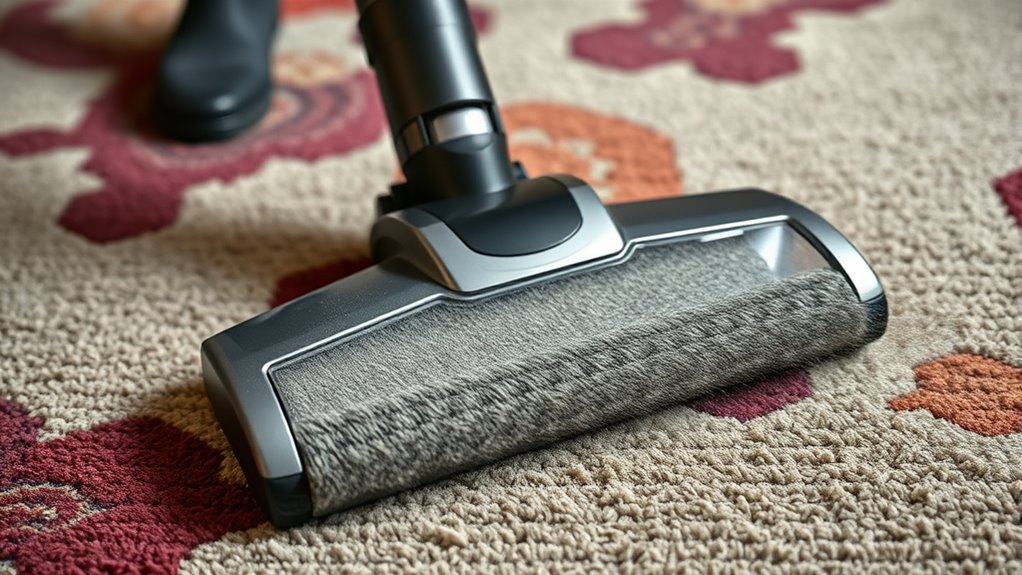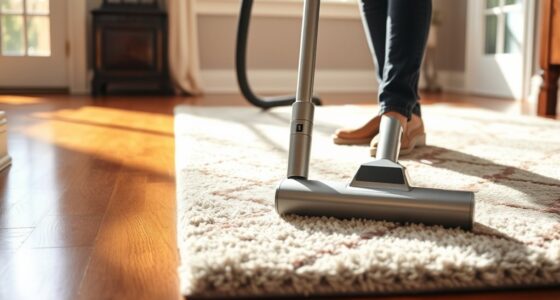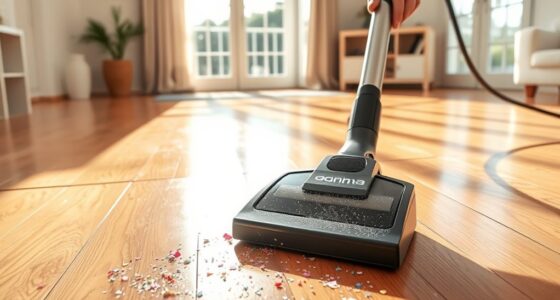Overlapping rows when vacuuming is essential because it guarantees every part of your carpet gets thorough cleaning. By making multiple passes and slightly overlapping each row, you remove more dirt, dust, and allergens, which helps protect your carpet’s fibers and prolong its lifespan. This technique also prevents missed spots that can accumulate debris over time. Keep going to discover how proper technique can make your carpet look better and last longer.
Key Takeaways
- Overlapping ensures thorough coverage, preventing missed spots and dirt buildup in carpets.
- It enhances dirt and debris removal by lifting more particles from carpet fibers.
- Proper overlaps reduce wear and tear, extending the carpet’s lifespan.
- Overlapping promotes deep cleaning, improving indoor air quality and allergen removal.
- Consistent overlapping minimizes the need for frequent deep cleaning and maintains carpet appearance longer.

Vacuuming carpets might seem straightforward, but paying attention to how you overlap your passes can make a significant difference. When you focus on proper vacuuming techniques, you not only remove dirt more effectively but also extend the life of your carpet. Overlapping rows ensure that no area gets missed, preventing dirt buildup and reducing wear over time. This attention to detail is a vital part of good carpet maintenance, helping your carpet look fresh and last longer.
Proper overlapping in vacuuming extends your carpet’s lifespan and keeps it looking fresh.
As you vacuum, aim to make multiple passes over each section of the carpet, slightly overlapping each row. This prevents gaps or missed spots, especially along the edges and in corners where dirt tends to accumulate. When you do this, you’re actively lifting more dirt and debris, including dust mites and allergens that can settle deep into the fibers. Proper overlap also reduces the chance of dirt being pushed around rather than picked up, which can happen if your passes don’t overlap enough. Think of it as a systematic approach that covers every inch thoroughly.
Using the right vacuuming techniques involves more than just moving the vacuum cleaner back and forth. It’s about creating a pattern that maximizes efficiency. For example, start by vacuuming in one direction, then go over the same area at a right angle, overlapping each pass slightly. This cross-hatching method ensures that all fibers are loosened and lifted, which improves overall carpet maintenance. If your vacuum has adjustable settings, use the highest suction and brush settings suitable for your carpet type. This enhances dirt removal and prolongs the appearance of your carpet.
Consistent overlapping not only improves dirt removal but also helps prevent premature wear. When dirt particles are left trapped, they can act like tiny abrasives, damaging fibers over time. Proper technique, including overlapping rows, minimizes this damage. It also reduces the need for deep cleaning or professional restoration, saving you time and money in the long run. Regular vacuuming with attention to overlaps also supports the longevity of your carpet fibers, keeping it in better condition for years to come.
Frequently Asked Questions
How Does Overlapping Improve Carpet Cleaning Efficiency?
Overlapping during vacuuming improves cleaning efficiency by ensuring you don’t miss any spots on your carpet. When you overlap rows, you cover the entire surface thoroughly, which is essential for effective vacuuming techniques. This helps remove dirt, dust, and debris more completely, promoting better carpet maintenance. By maintaining consistent overlap, you maximize cleaning results and extend your carpet’s lifespan, making your vacuuming routine more effective and efficient.
Can Overlapping Rows Damage Delicate Carpet Fibers?
Think of your carpet fibers as delicate threads in a tapestry; overlapping rows won’t tear them apart if you’re gentle. When vacuuming carefully, overlapping doesn’t cause vacuum damage or harm to the fibers. Instead, it guarantees thorough cleaning, removing embedded dirt without risking fiber damage. Just keep your movements steady and avoid pressing too hard, and your carpet stays pristine without risking the delicate fibers.
What Is the Best Pattern for Overlapping When Vacuuming?
The best pattern for overlapping when vacuuming is to use straight, overlapping passes in one direction, then switch to a perpendicular pattern. This guarantees thorough coverage and prevents missed spots. Your overlapping techniques should be gentle, avoiding excessive pressure that could damage fibers. By maintaining consistent overlapping, you’ll lift dirt effectively and extend your carpet’s lifespan, giving you a cleaner, fresher-looking surface with every vacuuming session.
Does Overlapping Help Remove Deeper Dirt Particles?
Coincidentally, overlapping rows do help remove deeper dirt particles by preventing dust dispersion and dirt redistribution. When you overlap, you’re ensuring every inch gets thorough coverage, pushing dirt out of carpet fibers more effectively. This technique minimizes missed spots, reducing dust dispersion and keeping dirt from settling back into your carpet. So, by overlapping, you boost your vacuuming’s effectiveness, making sure even stubborn grime gets lifted for a cleaner, healthier home.
How Often Should Overlapping Vacuuming Be Performed?
You should perform overlapping vacuuming at least once a week as part of your regular maintenance schedule. This frequency guarantees you effectively remove dirt and prevent buildup. If your household has pets or high foot traffic, consider increasing vacuuming sessions to twice a week. Overlapping rows help cover every inch thoroughly, maximizing dirt removal and keeping your carpets cleaner longer. Stick to this routine for healthier, fresher carpets.
Conclusion
By overlapping your vacuum passes, you guarantee every inch of your carpet gets thoroughly cleaned. For example, imagine missing a spot in the corner and letting dirt build up over time, leading to quicker wear. When you consistently overlap, you remove more dirt and extend your carpet’s lifespan. So, next time you vacuum, think of it as painting a wall—cover every section carefully to achieve a spotless, fresh look that lasts longer.









